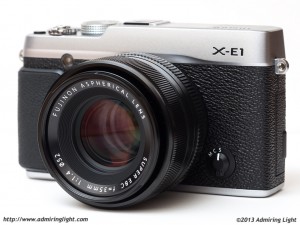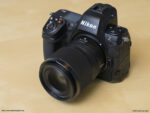Fujifilm X-Series
Of the three systems discussed here, the Fuji X series is the newest. Fujifilm released their X-Pro 1 about a year ago, and added the X-E1 later last year. Both cameras are meant to be purely still imaging machines (though they can do video), with an emphasis on a pure, simple, tactile control scheme. The Fuji X series uses old-school controls like dedicated aperture rings on all the lenses and dedicated shutter speed dials and exposure compensation dials. As a result, the Fuji X cameras are a joy to shoot with due to their simplicity and simple photographic purity. The image quality is also outstanding out of these cameras.

On the downside, Fuji has one of the poorer autofocus implementations in the mirrorless realm, and overall camera responsiveness lags behind the likes of Micro 4/3, Sony NEX and Nikon’s 1 series. Still, for deliberate shooting, it’s a great platform.
Lenses
The Fuji X-Series doesn’t have a large lens lineup, but unlike the other systems, Fujifilm targeted the enthusiast shooter from the start, releasing three prime lenses as the system’s initial lineup, an 18mm f/2 pancake, a 35mm f/1.4 and a 60mm f/2.4 Macro. Since that initial release, Fujifilm has released the 14mm f/2.8 ultra-wide, and two zooms, the 18-55mm f/2.8-4 and the 55-200mm f/3.5-4.8. Both zooms have a higher end aperture range than the typical consumer zooms that have made the early appearances on other systems.
These lenses have stellar optical quality. The three lenses I own for the system (the 14mm, 35mm and 60mm) are all outstanding optically, with the 14mm being one of the very best wide-angle lenses I’ve ever shot with. 2013 will see the release of even more great lenses for the system. On the roadmap for release in the next year are a 23mm f/1.4, a 56mm f/1.2, a 27mm f/2.8 pancake and a 10-24mm f/4 stabilized zoom. It’s safe to say given the extremely high quality of the existing lenses, that these future lenses will also be outstanding optics.
Additionally, Carl Zeiss has released its Touit line of lenses for Fuji X in addition to the Sony NEX line. This brings the Touit 12mm f/2.8 Distagon and 32mm f/1.8 Planar to the X-Series as well.
Among all the mirrorless systems, Fuji may have the most promise for the high-end shooter, providing outstanding glass and rapidly filling out a full system with excellent options. However, before they can become king of the hill, they need to make a big leap in autofocus performance, responsiveness and the few quirks that still plague some camera functions. This is an exciting company to watch!






Leave a Reply